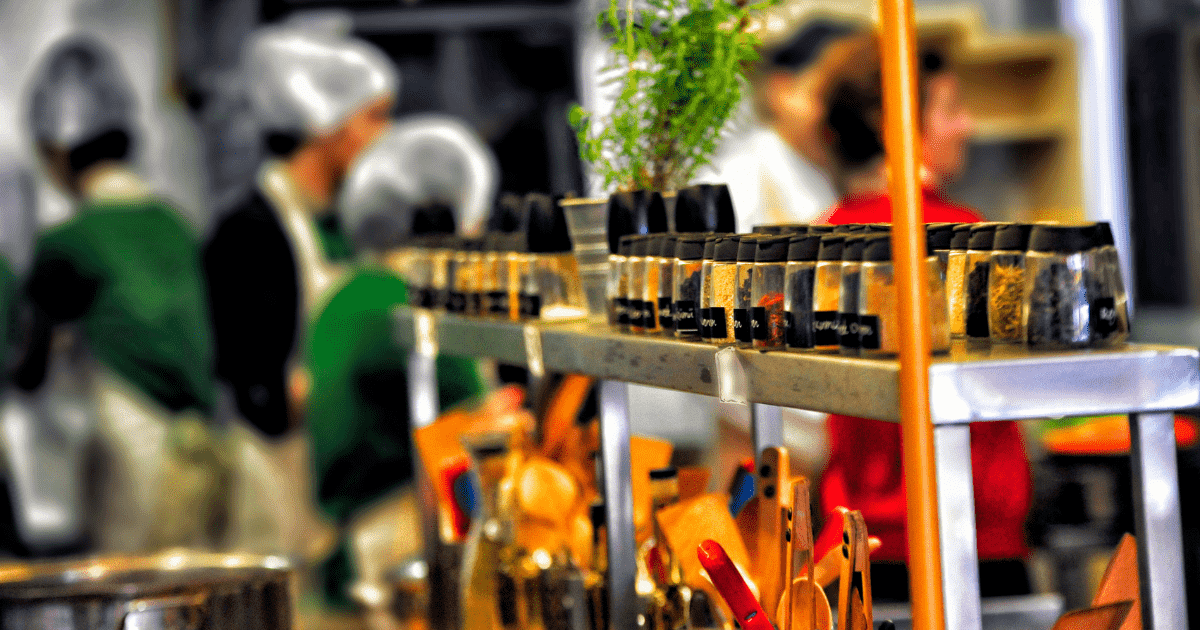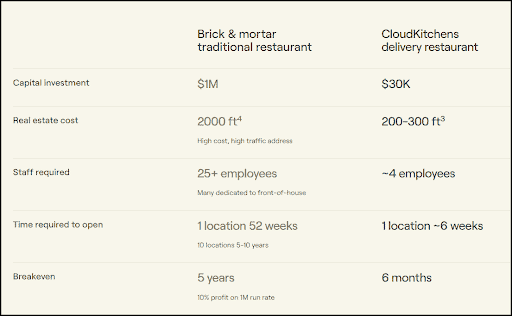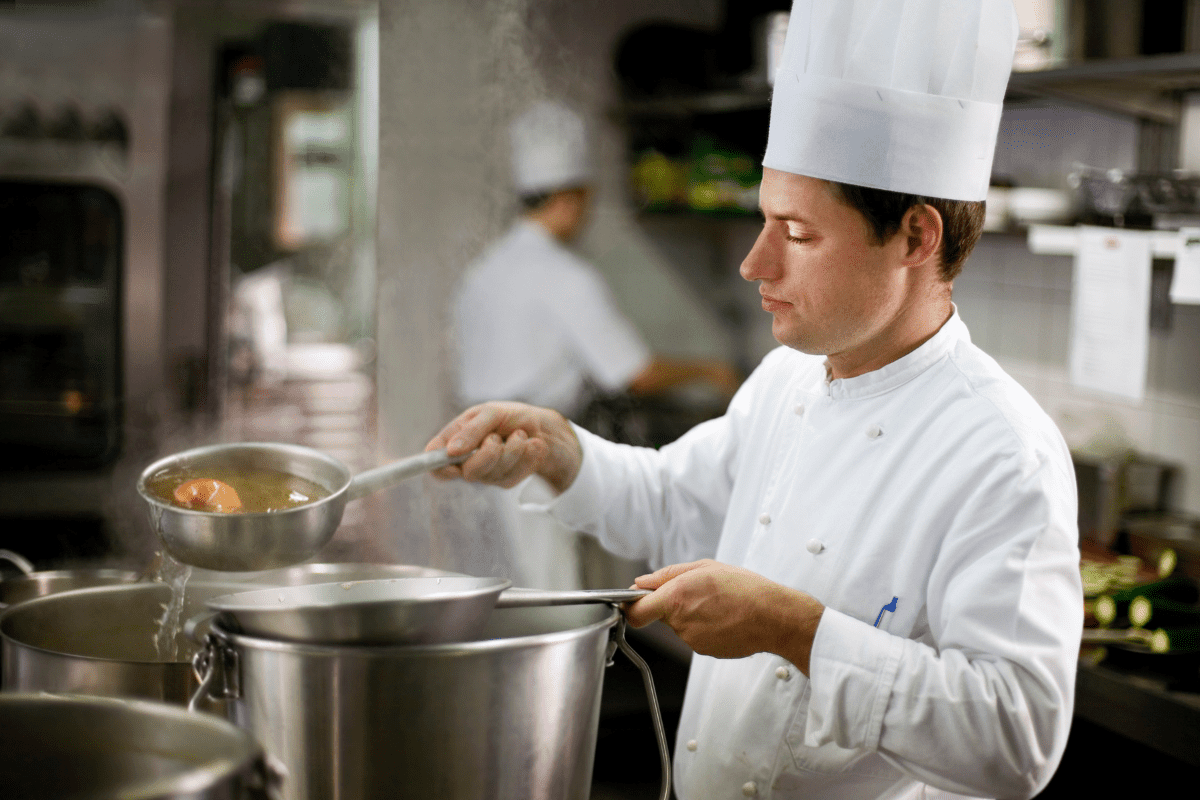I am not sure about the ghost thing ....but something different......... is always exciting .....apart from using a human eye socket as a sexual orifice......but apart from that i guess everything is on the table .......oh and donkey shows ,....no sireeeee bob !!!!!!!.........but ghost restaurants .........no kitchen .......how does on charge and make profit ........i thiught the profit was in the food ......not sure dont care .......but good luck chuck ......

Ghost Kitchens: All You Need to Know About The Trend That’s Disrupting the Restaurant Industry
What are ‘ghost kitchens’?
People are increasingly curious about this fast-growing trend disrupting the food industry.
Ghost kitchens are basically restaurants that don’t do dine-in. Instead, these eateries take customers’ orders online and only serve food via delivery or takeout. This post will discuss the benefits of a ghost kitchen and all the things you need to know about them before starting your own business!
Table of Contents
Ghost Restaurant vs. Traditional Restaurants
Ghost kitchens, also known as cloud or delivery-only restaurants, are a relatively new phenomenon. They do not have any physical space for customers to eat. Instead, they focus solely on food preparation. Ghost kitchens can be standalone businesses, or they can be affiliated with a traditional restaurant.
Ghost kitchens can quite easily integrate into existing restaurant operations. They also cut overhead costs since they don’t need to maintain a dining area or pay waitstaff.
Ghost kitchens also typically have more limited menus than their brick-and-mortar counterparts because they only need to prep food for takeout or delivery rather than accommodate dine-in customers.
Often ghost kitchens specialize in a particular cuisine rather than serve a wide variety of dishes. This specialization helps to streamline food preparation and optimize the quality of each dish.
Finally, ghost kitchens often rely on third-party delivery services like GrubHub, Postmates, or Doordash to get food to their customers. By comparison, traditional restaurants usually manage their own delivery staff.

Source: CloudKitchen.com
The growing appeal of Ghost Kitchens
Several factors make ghost kitchens appealing to food businesses. Firstly, they’re much cheaper to set up and run than traditional restaurants. Without a dining area, ghost kitchens can be smaller and require less staff.
Additionally, ghost kitchens have more flexibility when it comes to location. Whereas legacy restaurants try to pick spots with high pedestrian traffic, ghost kitchens can choose to get close to food production facilities instead. This reduces food waste and saves on transport costs.
Finally, ghost kitchens can be geared specifically towards delivery and takeout orders. This is becoming increasingly popular as people are busier and want the convenience of having food delivered to their doorstep.
It’s no wonder that ghost kitchens are trending. According to the Huhtamaki 2022 Q1 trends report, 51% of restaurateurs have already made the shift to virtual kitchens in response to changing consumer habits.
Pros & Cons of Ghost Kitchen
Overall, ghost kitchens present new opportunities and challenges for business owners.
Cutting kitchen management costs is a big plus for ghost kitchens. They employ less cooking staff and have a more straightforward kitchen layout. This optimizes efficiency and reduces labor costs.
However, ghost kitchens can also pose some challenges. For example, because customers can’t come into the kitchen to order food, business owners need to get creative in their marketing efforts so potential customers know about their menu and meal plan options. They also need more careful planning to ensure orders are placed promptly and correctly.
Types of Ghost Kitchen
We’ve seen a few different types of ghost kitchens emerge as this business model evolves. Here’s a quick rundown of the most common:
Incubator Ghost Restaurants: These are typically startups that partner with an existing restaurant or foodservice business that provides them with space, equipment, and sometimes even staff. In exchange, they usually get a cut of the profits. Examples of Incubator ghost restaurants are ShiftPixy, and the Denver Lobster stop launched by the Blue Island Oyster Bar.
Entrepreneur Ghost Restaurants: As the name suggests, these are businesses started by entrepreneurs who saw an opportunity in the ghost kitchen industry. They are also known as “shared kitchens” or “commissary kitchens.” They often lease space in commercial kitchens or other food-related businesses and outsource everything from staffing to marketing. It’s a cost-effective way to get into the ghost kitchen game since you share the space and equipment with other businesses/kitchen brands. Examples of Entrepreneur Ghost Restaurants in the US are Kitchen United, Cloud Kitchens, Gabriella’s New York City Pizza, and REEF Kitchens.
Kitchen Pods: These are self-contained units that can be placed anywhere. They come equipped with everything a restaurant needs to operate, from cooking equipment to ventilation and refrigeration. Kitchen pods are becoming increasingly popular with ghost kitchen operators as they offer greater flexibility in terms of location. Examples of American kitchen pods include Mobile Kitchens USA, KitchenPodular, Zuul Kitchen, and TemporaryKitchens123.
Basic Steps for setting up a ghost Kitchen
By renting out space in a shared kitchen, ghost kitchens can help to reduce the overhead costs associated with traditional restaurants. However, setting up a ghost kitchen can be a bit of a challenge. Here are a few tips to help you get started:
1. Start by finding the right location.
Ghost kitchens typically require less space than traditional restaurants, so you may be able to find a smaller space that is more affordable. Just be sure to pick an ideal location.
2. Kitchen Appliances
Next, you’ll need to outfit your kitchen with the necessary equipment, including refrigeration, freezer, coffee maker, dishwasher, and blender. Be sure to choose energy-efficient appliances to help keep your operating costs down.
3. Decide Your Menu
Once you have your equipment in place, it’s time to start thinking about your menu items. Ghost kitchens typically specialize in one or two cuisines, so choosing dishes that appeal to your target market is essential. Keep your menu simple at first, and then you can gradually add more items as you get more comfortable with the operation of your ghost kitchen.
4. Marketing Plan for your Ghost Kitchen
Finally, be sure to promote your ghost kitchen online and through word-of-mouth. Social media is a great way to reach potential customers and tell them about your new business venture. Handing out flyers in high-traffic areas can also help to generate interest in your ghost kitchen.
Costs of Setting up a ghost kitchen
Ghost kitchens offer a cost-effective way to open a new restaurant. However, there are still some serious costs to consider. For example, you will need to purchase or lease commercial kitchen space and fit the kitchen with appliances and dishwashers. You’ll also have to factor in staff costs. Ghost kitchens can be a significant investment, but they certainly lower the entry barrier to the restaurant industry.
The basic costs of starting a ghost kitchen are:
- Rental rates for a commercial kitchen: $20-$45/hour, depending on the location and contract length.
- Leasing a commercial kitchen: $2.05/sq. Foot per month.
- Equipments & Appliances: upwards of $45,000.
- City permits, licenses, and fees: $175-$8,500 excluding liquor licenses.
- POS system: $80-150/month for software, plus one-time hardware costs.
Try Restaurant Dive’s ‘ghost kitchen calculator‘ to calculate your potential costs.
Frequently Asked Questions about Ghost Kitchens & Restaurants
How can I convert my restaurant into a ghost kitchen?
Many restaurant owners wonder how they can transform their existing restaurants into ghost kitchens.
The first step is to assess your kitchen appliances and equipment. You can repurpose dishwashers and other large appliances for ghost kitchen use. Still, you’ll also need to invest in some new kitchen equipment, such as countertop burner sets and commercial-grade refrigerators.
Once you have the necessary equipment, you can revamp your menu for a ghost kitchen format. Simple dishes like burgers and pizzas are well-suited to ghost kitchens, as they can be prepared quickly and don’t require a lot of complicated ingredients. By making these simple changes, you can easily convert your restaurant into a ghost kitchen.
What is the difference between a ghost kitchen and a dark kitchen?
A ghost kitchen is a restaurant existing only in the virtual world and has no physical dining locations. These businesses, by design, provide customers with a seamless delivery-only experience at a fraction of the price of traditional casual restaurants and often partner with popular food delivery apps.
Dark kitchens, on the other hand, are physical restaurants that don’t cater to walk-in customers. Instead, these businesses focus on takeout and delivery orders and typically don’t have any seating or decor. In addition, dark kitchens often partner with ghost kitchens, which allows them to reach a broader range of customers.
However, some dark kitchens have their own branded apps and websites, allowing them to control the customer experience from start to finish.
How profitable are ghost kitchens?
Restauranteurs, real estate developers, and food service operators have been wondering about ghost kitchens’ profitability for the past few years.
There are several factors to consider when evaluating whether or not a ghost kitchen will be profitable. These include the initial investment, the type of food served on the menu, the delivery platforms used, and the overhead costs. According to Cloud Kitchens, some ghost kitchens can break even in 6 months with a $30k capital outlay.
To answer the question: yes, ghost kitchens can be profitable. But there’s a lot more to it than that.
Use this calculator to crunch some numbers and determine the profitability of a ghost kitchen.
Conclusion
If you’re looking for a new culinary experience or want to support local businesses, keep an eye out for ghost kitchens in your area. These innovative restaurants are shaking up the food industry, especially in the United States urban areas, and are here to stay. So go ahead and order that salad—it’ll be made fresh and delivered right to your door.
That concludes our blog post about ghost kitchens. We hope you found it informative and that it’s given you a better understanding of this new restaurant trend.
Bon appetite!
This article originally appeared on My Work From Home Mo


No comments:
Post a Comment